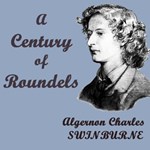Algernon Charles Swinburne
Download the book
A roundel (not to be confused with the rondel) is a form of verse used in English language poetry devised by Algernon Charles Swinburne (1837–1909). It is a variation of the French rondeau form. It makes use of refrains, repeated according to a certain stylized pattern. A roundel consists of nine lines each having the same number of syllables, plus a refrain after the third line and after the last line. The refrain must be identical with the beginning of the first line: it may be a half-line, and rhymes with the second line. It has three stanzas and its rhyme scheme is as follows: A B A R ; B A B ; A B A R ; where R is the refrain. Swinburne had published a book A Century of Roundels. He dedicated these poems to his friend Christina Rossetti, who then started writing roundels herself, as evidenced by the following examples from her anthology of poetry: Wife to Husband; A Better Resurrection; A Life's Parallels; Today for me; It is finished; From Metastasio.
 Download the book
Download the book
